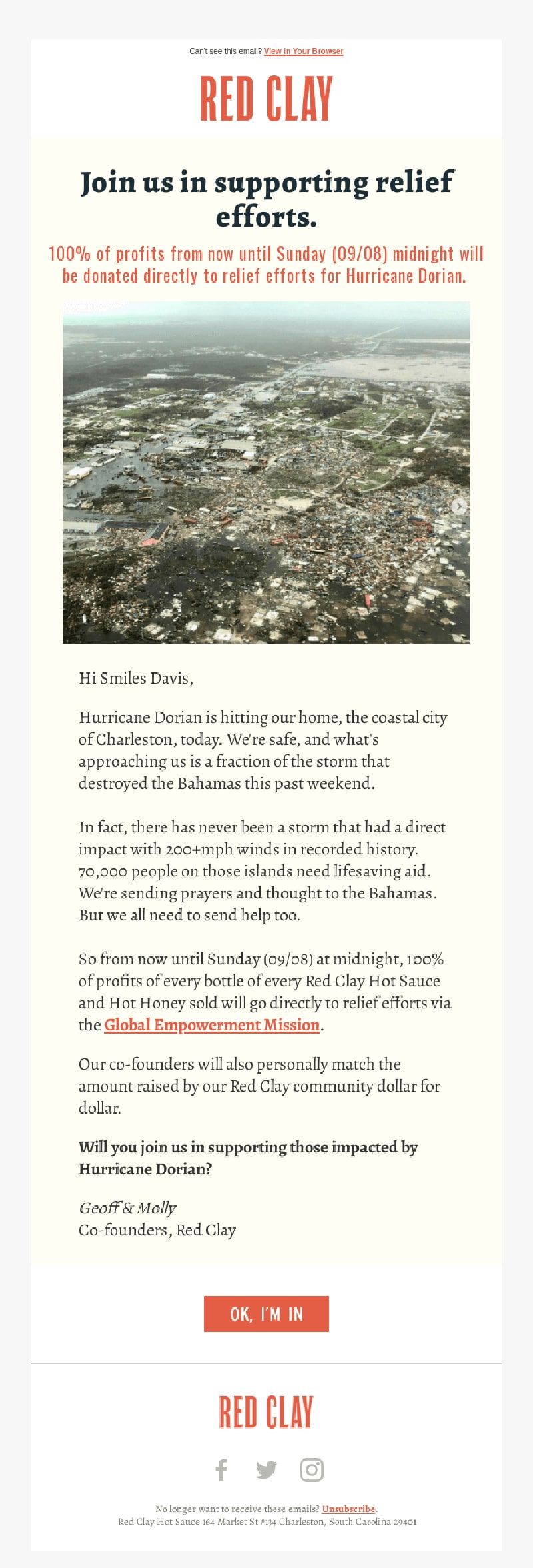As COVID-19 impacts a variety of industries worldwide, nonprofit organizations are among the most heavily affected. The human and economic toll of this pandemic is immeasurable.
With business closures and company layoffs, businesses and community members have less money to contribute to philanthropy.
Social distancing policies and stay-at-home mandates mean in-person events like fundraiser galas and walks/runs are canceled. Nonprofits rely on these sources of contributions to keep their organizations running.
How can nonprofits drive donations during times of economic uncertainty? Campaign Monitor can help.
Communicating with donors
Nonprofits know the importance of fostering strong relationships with their donors. Economic uncertainty is the time to strengthen those ties and lean on donors for support. As you begin to re-evaluate your marketing plan to navigate these hard economic times, you’ll want to determine how your donors prefer to receive messages from you. This is a crucial time for effective communication.
According to a recent study, 41.6% of donors prefer email as their primary form of contact with nonprofits. Additionally, 17% said they want to receive an email from an organization representative.
Source: Campaign Monitor
Clearly, email is an effective marketing tool for nonprofits and should be used in your communications strategy. It’s a trusted and secure avenue, widely used across all demographics. Its combination of images and text provide an effective tool for telling a story. Whether that story focuses on your charity or the needs you’re meeting with donor funds, these emails help you connect with your audience on a personal level. That kind of connection can lead to more support for your organization.
Source: Campaign Monitor
Effective email messaging
Now that you know how to reach your audience, the next step is to determine the approach to your messaging. Your organization may indeed be suffering from the economic downturn caused by COVID-19. But reaching out with emergency solicitations may not only keep donors from responding; it may turn them off from making future contributions.
Donors view their contributions as investments, and nobody wants to invest in an organization on the brink of financial ruin. They want to feel that their money is being used wisely to help toward long-term success. Here are ways email communications can strengthen your relationship with donors and drive donations during economic uncertainty.
Be transparent.
While you shouldn’t emphasize the ways your organization is suffering, it’s essential to be open about the challenges your nonprofit is facing. Explain to donors why your services are important, especially now, when times are hard for so many. Address strategies you have for moving forward. Outline ways their support can alleviate the vital need created by COVID-19. Thoughtfully explain the urgency involved while informing, inspiring, and finding ways to collaborate as you work toward a solution. Remind them that their funds not only help your organization but help the community you serve.
Be grateful.
Appreciation goes a long way. Research shows that the primary reason donors stopped giving to a charity was that they no longer felt connected to the organization. No matter their level of contribution, all donors need to feel that their generosity is appreciated. There are any number of other ways people could be using their money. When they choose your organization, especially in a time of financial uncertainty, they deserve to be acknowledged.
Personal thank you emails can be achieved in several ways. Highlight a specific example of how donor funds have benefited others. Consider including a brief video portraying ways the donor’s gifts are making a difference. Take a celebratory approach. Rather than simply thanking them, congratulate them for their role in helping to achieve a goal. These kinds of communications help donors feel connected to your organization and increase the likelihood that they’ll contribute in the future.
Source: Campaign Monitor
Be specific.
Studies show that 68.8% of donors are more likely to give a donation when faced with a specific, compelling need. The economic toll of today’s pandemic may indeed be impacting your organization in several ways. Assess your needs and ask for funds that could be targeted for specific uses. People seem to be more generous when they see how their donations can solve a particular issue.
Asking for a large, seemingly arbitrary amount of money can be overwhelming and off-putting to donors. Those who can’t afford such an amount may disregard the gift entirely, assuming someone with more resources will cover that cost. By assigning a specific amount of money to a certain need, donors see the donation as financially manageable. They’ll understand how far their gift will go and how it’ll help. This can lead to an increase in contributions.
Source: Campaign Monitor
Components of an effective email
Email messaging is extremely important. But features that entice contributors to open emails, digest them, and take action are even more important. A compelling story doesn’t do any good if it winds up in people’s trash bins. Consider these components to build a successful email campaign to drive donations to your organization.
Enticing subject lines
Email subject lines with seven words tend to lead to higher click-through rates. With such a small number, you’ll want to choose your words carefully. Replace “donate” with “helping” and “fundraising,” as these resonate better with potential donors. Emphasize importance with words like “now” and “urgent” and reference timelines such as “tomorrow” and “midnight.” These not only give a sense of urgency, but they appeal to a reader who doesn’t want to miss out on an opportunity.
Use the subject line to ask a question. Get people thinking and considering their role and whether they’ll take action to help. Add a personal touch to your message by tailoring the subject line with a reader’s first name. Examples of effective subject lines for nonprofit emails include:
- You can be a hero for $25
- We can’t solve {problem} without you, {first name}
- {First name}, will you help us reach our goal?
- Donate by midnight to help save lives
- Your last chance to support {cause}
Manageable content
While it’s important to share your story, people are only willing to invest so much money and time. Convey the need for donor assistance in short paragraphs that are easy to read. Overwhelming text isn’t compelling and can actually serve as a detriment to your cause. Make it personal, appealing, and concise.
Source: Really Good Emails
Clear CTA
A CTA is one of the most important elements of your email, as this directs people to make a move. Use direct, simple messaging, so it’s clear what you’re asking of your readers. Appeal to your audience by evoking emotion. Give them a sense of the importance of their contribution and urge them to become involved. Call for an action that relates specifically to your cause. Take the guesswork out of donations and use a CTA that clearly defines the donor’s role. Lastly, the CTA should be prominent and easy to find in your email. Examples of effective CTA for your emails include:
- Sign up to volunteer
- Inspire change
- Support a child
- Volunteer to plant a rose garden
- Donate $20
Source: Eisemann Center for Performing Arts
More ways to succeed
An effective email marketing strategy isn’t the only way to drive donations during COVID-19. Seek assistance beyond financial support. In an economic crisis, there are several ways people can help without spending any money. Ask donors for their advice and help in creating a strategy and inquire whether they can make introductions to other prospects. See how supporters can prepare matching gifts to help drive more donations and determine the strategic plans foundational donors employ when resources are limited. See what advice they can offer to help you position your cause as a priority to others.
It’s a great time to build your online presence. The internet offers a variety of benefits to nonprofits, allowing you to reach a younger target audience and provide followers with more ways to participate in your efforts. By building a social media following and creating compelling content, you’ll engage followers and increase support for your cause. Think about using online video conferencing tools to connect with your audience on a more personal level.
Wrap up
The economic impact of COVID-19 is far reaching and potentially long lasting. As a result, charitable organizations should focus on an effective email campaign to appeal to donors and connect them with your mission. Nonprofits can drive donations during times of economic uncertainty by taking the following actions:
- Connect with donors through transparent messaging
- Show gratitude for the offerings of your constituents
- Be specific in your asks
- Create emails with strong subject lines, concise content, and a compelling CTA
- Ask for help from and collaborate with experienced individuals
- Build an online presence
Reassess your goals, continue to foster relationships with your constituents, and stay the course. Your donors want you to succeed and, with a thoughtfully planned email campaign, they’ll help you survive an economic downturn.
For more information about how we can help your nonprofit with email marketing after COVID-19, contact our sales team today.











